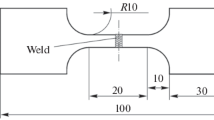Abstract
Results of an experimental study of the structure, the phase composition, and the mechanical properties of laser-welded joints of 3-mm thick titanium and 12Kh18N10T steel sheets obtained with the use of intermediate inserts and nanopowdered modifying additives are reported. It is shown that that such parameters as the speed of welding, the radiation power, and the laser-beam focal spot position all exert a substantial influence on the welding-bath process and on the seam structure formed. In terms of chemical composition, most uniform seams with the best mechanical strength are formed at a 1-m/min traverse speed of laser and 2.35-kW laser power, with the focus having been positioned at the lower surface of the sheets. Under all other conditions being identical, uplift of the focus to workpiece surface or to a higher position results in unsteady steel melting, in a decreased depth and reduced degree of the diffusion-induced mixing of elements, and in an interpolate connection formed according to the soldering mechanism in the root portion of the seam. The seam material is an over-saturated copper-based solid solution of alloying elements with homogeneously distributed intermetallic disperse particles (Ti(Fe, Cr)2 and TiCu3) contained in this alloy. Brittle fracture areas exhibiting cleavage and quasi-cleavage facets correspond to coarse Ti(Fe, Cr)2 intermetallic particles or to diffusion zones primarily occurring at the interface with the titanium alloy. The reported data and the conclusions drawn from the numerical calculations of the thermophysical processes of welding of 3-mm thick titanium and steel sheets through an intermediate copper insert are in qualitative agreement with the experimental data. The latter agreement points to adequacy of the numerical description of the melting processes of contacting materials versus welding conditions and focal-spot position in the system.
Similar content being viewed by others
References
G.I. Kapyrin, Titanium Alloys in Engineering, Mashinostroenie, Leningrad, 1977.
U. Cvikker, Titanium and Titanium Alloys, Metallurgiya, Moscow, 1979.
W.M. Steen and J. Mazumder, Laser Material Processing, Springer, London, 2010.
S.I. Kuchuk-Yatsenko, Yu.V. Shvets, S.D. Kavunichenko, V.I. Shvets, S.D. Tatarenko, and V.A. Proshchenko, Influence of stainless-steel insert width on the performance characteristics of frog joints with rail ends, Avtomaticheskaya Svarka, 2007, No. 3, P. 3–7.
A.N. Cherepanov, Yu.V. Afonin, and A.M. Orishich, Laser welding of steel with a titanium alloy with the use of intermediate inserts and nanopowder inoculators, Tyazheloe Meshinostroenie, 2009, No. 8, P. 24–26.
N.B. Pugacheva, E.B. Trushina, E.I. Pugacheva, A.M. Orishich, and A.N. Cherepanov, Structure of welded seams of 18Kh18N10T steel and VT1-0 titanium alloy interfaced with an intermediate copper insert after laser melting, Voprosy Materialovedeniya, 2013, No. 1(73), P. 166–174.
Ch. Yao, B. Xu, X. Zhang, J. Huang, J. Fu, and Y. Wu, Interface microstructure and mechanical properties of laser welding copper-steel dissimilar joint, Optics and Lasers in Engng, 2009, Vol. 47, No. 7, P. 807–814.
State Standard (GOST 6996-66), Welding Joints: Methods for Determining the Mechanical Properties. Introduction. 1967-01-01, Izdatelstvo Standartov, 1966.
V.P. Shapeev, V.I. Isaev, and A.N. Cherepanov, Simulation of thermophysical processes in the laser welding of sheets of dissimilar materials using inter-inserts, in: Proc. V All-Union Conference “Interaction of highly concentrated energy fluxes with materials in advanced technologies and medicine”, Parallel, Novosibirsk, 2013, P. 192–194.
Author information
Authors and Affiliations
Corresponding author
Additional information
This work was financially supported by the Russian Foundation for Basic Research (Grants Nos. 14-08-00633 and 13-01-227).
Rights and permissions
About this article
Cite this article
Cherepanov, A.N., Orishich, A.M., Pugacheva, N.B. et al. Investigation of the structure and properties of titanium-stainless steel permanent joints obtained by laser welding with the use of intermediate inserts and nanopowders. Thermophys. Aeromech. 22, 135–142 (2015). https://doi.org/10.1134/S0869864315020018
Received:
Published:
Issue Date:
DOI: https://doi.org/10.1134/S0869864315020018




